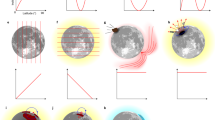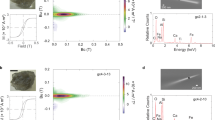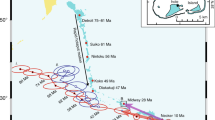Abstract
It is generally believed that the Earth's magnetic field arises from dynamo action in the convecting outer core1–3. Thus the geomagnetic field, and especially its strength, can provide information about core processes. Recent determinations of the geomagnetic palaeointensity using Archaean and early Proterozoic samples from the Kaapvaal and Superior cratons are consistent with a sharp increase in the magnitude of the geomagnetic field between 2.7 and 2.1 Gyr. Analysis of published late Archaean and early Proterozoic apparent polar wander paths shows that an abrupt change in the rate and style of continental motion occurred at about 2.5–2.6 Gyr ago. If this change is also interpreted to be related to the growth of an inner core, then, an intriguing conjecture arises that the Archaean–Proterozoic transition is related to inner core nucleation.
This is a preview of subscription content, access via your institution
Access options
Subscribe to this journal
Receive 51 print issues and online access
$199.00 per year
only $3.90 per issue
Buy this article
- Purchase on Springer Link
- Instant access to full article PDF
Prices may be subject to local taxes which are calculated during checkout
Similar content being viewed by others
References
Jacobs, J. A. in Physics of the Earth's Interior (Soc. Italiana di Fisica, Bologna, 1980).
Gubbins, D. Contemp. Phys. 25, 269–290 (1984).
Stevenson, D. J. Rep. Prog. Phys. 46, 555–620 (1983).
Safravanov, V. S. Nauka, Moscow (1969); transl. NASA TTF-667 (1972).
Kaula, W. Geol. Soc. Can. Spec. Pap. No. 20 (1980).
MacDonald, G. J. F. J. geophys. Res. 67, 167 (1959).
Runcorn, S. K. Nature 270, 676 (1978).
Tozer, D. C. Geophys. J. 9, 95 (1965).
Flaser, F. M. & Birch, F. J. geophys. Res. 78, 6101 (1973).
Braginsky, S. I. Zh. Eksper. i. Teor. Fiz. 47, p. 2178 Sov. Phys. JETP English Translation 20 (1965), 1462 (1964).
Gubbins, D. J. geophys. 43, 453 (1977).
Stevenson, D. J., Spohn, T. & Schubert, G. Icarus 54, 466–489 (1983).
Hale, C. J. thesis, Univ. Toronto (1985).
Hale, C. J. Earth planet. Sci. (in the press).
Schwarz, E. J. & Symons, D. T. A. Phys. Earth planet Int. 2, 11–18 (1969).
McElhinny, M. & Evans, M. E. Phys. Earth planet Int. 1, 485–497 (1968).
Pesonen, L. & Halls, H. C. Geophys. J. R. Soc. 73, 241–270 (1983).
Nelson, B. K. & DePaolo, D. J. Geol. Soc. Am. 96, 746–754 (1985).
Vogt, P. R. Earth planet. Sci. Lett. 25, 313–321 (1975).
McFadden, P. L. & Merrill, R. T. J. geophys. Res. 89, 3354–3362 (1984).
Hale, C. J. & Dunlop, D. J. Geophys. Res. Lett. 11, 97–100 (1984).
McElhinny, M. W. & Senenayake, W. E. J. geophys. Res. 85, 3523–3528 (1980).
Dunlop, D. J. Can. J. Earth Sci. 21, 869–878 (1984).
Beck, M. E. Jr. Am. J. Sci. 276, 694–712 (1976).
Irving, E. & Naldrett, A. J. Geology 85, 157–176 (1977).
Schutts, L. D. & Dunlop, D. J. Nature 291, 642–645 (1979).
Ridler, R. H. & Foster, J. H. Geol. Surv. Can. Pap. No. 77-10 (1981).
Geissman, J. W. M., Strangway, D. W., TasilloHirt, A. & Jensen, L. S. Can. J. Earth Sci. 19, 2085–2099 (1982).
Tasillo-Hirt, A. M., Geissman, J. W., Strangway, D. W. & Jensen, L. S. Can. J. Earth Sci. 19, 2100–2113 (1982).
Symons, D. T. A., Quick, A. W. & Stupavsky, M. Ontario Geol. Survey Misc. Pap. No. 98 293–307 (1981).
Dunlop, D. J. Can. J. Earth Sci. 20, 1805–1817 (1983).
Giddings, J. W. Tectonophysics 30, 91–108 (1976).
Evans, M. E. J. geophys. Res. 7, 3261–3270 (1968).
Porath, H. & Chamalaun, F. H. Geophys. J. 15, 253–264 (1968).
Embleton, B. J. Precambr. Res. 6, 275–291 (1978).
Evans, M. E. & McElhinny, M. J. geophys. Res. 71, 6053–6063 (1966).
Henthorn, D. I. thesis, Univ. Leeds (1973).
Jones, D. L., Robertson, I. D. M. & McFadden, P. L. Trans. Geol. Soc. S. Afr. 78, 57–65 (1976).
Author information
Authors and Affiliations
Rights and permissions
About this article
Cite this article
Hale, C. Palaeomagnetic data suggest link between the Archaean–Proterozoic boundary and inner-core nucleation. Nature 329, 233–237 (1987). https://doi.org/10.1038/329233a0
Received:
Accepted:
Issue Date:
DOI: https://doi.org/10.1038/329233a0
This article is cited by
-
Possible generation of heat from nuclear fusion in Earth’s inner core
Scientific Reports (2016)
-
The Magnetic Field of Planet Earth
Space Science Reviews (2010)
-
Observations and Models of the Long-Term Evolution of Earth’s Magnetic Field
Space Science Reviews (2010)
-
Early precambrian banded iron formations: Biochemical precipitates from highly evaporated hydrothermal solutions of polar region lakes
Carbonates and Evaporites (2009)
-
Changes in earth’s dipole
Naturwissenschaften (2006)
Comments
By submitting a comment you agree to abide by our Terms and Community Guidelines. If you find something abusive or that does not comply with our terms or guidelines please flag it as inappropriate.



